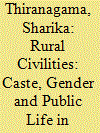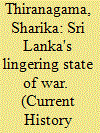|
|
|
Sort Order |
|
|
|
Items / Page
|
|
|
|
|
|
|
| Srl | Item |
| 1 |
ID:
184795


|
|
|
|
|
| Summary/Abstract |
In 2011, Sri Lanka experienced a wave of ‘grease devil’ attacks—men covered in grease assaulting women. In minority Tamil and Muslim areas, these incidents provoked vigilantism and clashes between locals and the police and the military. This essay examines these incidents through situating them in histories of intense militarisation and current post-war anxieties for ethnic minorities in Sri Lanka. Drawing inspiration from anthropologist James Siegel’s work, it analyses how subterranean forms of violence, currently undertaken by the state, as well as longer histories of political violence unforgotten but publicly disallowed, resurface via proxy figures and a more generalised sense of menace. This history and ongoing militarisation and securitisation produce both ethnically differentiated landscapes, and mark and shape desires in fearful and securitised ways.
|
|
|
|
|
|
|
|
|
|
|
|
|
|
|
|
| 2 |
ID:
118904


|
|
|
|
|
| Publication |
2012.
|
| Summary/Abstract |
This paper takes as its subject the 1905 opening and 1990 closure of the Northern Railway Line, the major Sri Lankan railway which ran the length of the island from south to north. It argues that it can been seen as a social compact in which the life of the individual, the community, and the state became integrally intertwined. It focuses on two dimensions of what the Northern Railway Line enabled in Sri Lanka (formerly Ceylon): first, a physical and symbolic representation of stateness, and, secondly, the pursuit of mundane everyday life. These are embedded within Sri Lanka's landscapes and histories of colonial and post-colonial rule, and the ethnic conflict, riots, and war which inextricably shaped the railway's journeys and passengers. Railways are more often thought of as large-scale, high-tech artefacts rather than the smaller everyday technologies that are the themes of other papers in this special issue. However, this paper highlights the ways in which railways also make particular kinds of everyday life possible and how, in being woven into routine daily and weekly journeys, the Northern Railway Line came to intertwine the changing circumstances and histories of its mainly Tamil passengers within an increasingly ethnicized national landscape. In the aftermath of its closure, the railway has now come to symbolize a desire for a return to the normalcy of the past, an aspiration to an everyday experience that younger generations have never had, and which has, in consequence, become a potent force.
|
|
|
|
|
|
|
|
|
|
|
|
|
|
|
|
| 3 |
ID:
165935


|
|
|
|
|
| Summary/Abstract |
This essay investigates how public life in Kerala is shaped by spatially distributed gendered caste practices. The essay first investigates rural publics, such as rural libraries, and suggests that forms of progressive civility in seemingly caste-free associational publics should be understood not as the elimination of caste practices but their reconstitution. Second, while it is commonly accepted that caste is naturally practised in the ‘private’, I suggest that these ‘privates’ are in fact what I call a ‘private–public’ and are spatially and socially shaped by gender and caste. I argue that ideas of civility and democracy need to understand experiences of forms of civility and incivility as constituted in private–publics rather than only in the formal associational public.
|
|
|
|
|
|
|
|
|
|
|
|
|
|
|
|
| 4 |
ID:
129654


|
|
|
|
|
| Publication |
2014.
|
| Summary/Abstract |
In November 2012, workers digging in the compound of a hospital in Matale, in central Sri Lanka, uncovered human remains. A full excavation revealed some 154 skeletons. Forensic reports point to signs of torture on the bodies and evidence of unnatural deaths (such as decapitation). Artifacts buried with the bodies indicate a time frame of 1986-90, precisely the period of fighting between the Sri Lankan state and the Sinhalese nationalist insurrectionary group Janatha Vimukthi Peramuna (JVP), which resulted in an estimated 60,000 missing and feared dead. Officials have rejected the dating of the bodies and claim that they are from the 1940s. North of Matale are the areas where the final battles of Sri Lanka's civil war took place. Many analysts, including members of the United Nations agency tasked with investigating accounts of the last battles, suggest that nearly 40,000 Tamil civilians died there between February and May 2009. In January of this year, another mass grave was uncovered, this time in northern Mannar. The
state claims that it contains the remains of those killed by the Tamil Tigers, also known as the Liberation
Tigers of Tamil Eelam (LTTE); civil society figures argue that the dead were victims of the army. Excavation has halted, and the Archaeological Board has suggested that this site might in fact be a normal cemetery.
|
|
|
|
|
|
|
|
|
|
|
|
|
|
|
|
|
|
|
|
|